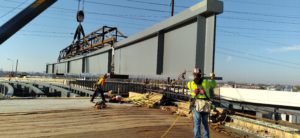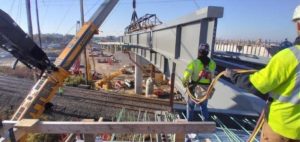(Photos provided courtesy of PennDOT)
 In March 2021, HRV ventured into “unchartered territory” as far as the quality assurance oversight and inspection world is concerned. That’s when High Steel Structures began the fabrication and coating of five, 145-foot-long curved steel, tubular flange bridge girders in their Lancaster, Pennsylvania fabrications facility for a new PennDOT District 6 bridge, located on Interstate 95 near Philadelphia.
In March 2021, HRV ventured into “unchartered territory” as far as the quality assurance oversight and inspection world is concerned. That’s when High Steel Structures began the fabrication and coating of five, 145-foot-long curved steel, tubular flange bridge girders in their Lancaster, Pennsylvania fabrications facility for a new PennDOT District 6 bridge, located on Interstate 95 near Philadelphia.
High Steel’s fabrication contract with PennDOT included a unique technology/R&D component that proved to be helpful in the fabrication process—virtual QA inspection. The technology, XpertEye, allowed HRV QA inspectors John Haskett and Gary Wolf to perform visual inspections on the first-ever tubular girders using a heads-up display that was also being viewed by project engineers and HRV’s QA Project Manager David Wright from their offices. This wi-fi/web-based system allowed the technical experts to observe and hear all the inspection activities and helped them identify fabrication and welding issues in real-time. The XpertEye inspections were performed three times a week for about an hour and a half during daylight shifts
“One of the key benefits of applying this technology is that project engineers and technical experts do not have to physically be in the fab shop to witness the inspection and provide technical guidance when needed,” said Wright. “It not only facilitates immediate technical expertise but helps reduce project costs related to travel and expenses.”
Safety is an additional feature benefit of using the virtual inspection technology.
“Because of the length and ‘sweep’ or the degree of curvature of these girders, High Steel needed to manufacture their own unique lifting apparatus,” continued Wright. “Without virtual inspection capabilities, more shop workers and technical experts are potentially put at risk because of how the girders had to be handled using these new lifts.”
The new bridge, constructed by Buckley and Company, was erected in late December 2021. While this bridge project demonstrates a highly innovative design and increased structural performance, it also created a potential path through “unchartered territory” toward for more efficient, cost-effective, and safe QA inspections in fabrication shops.

